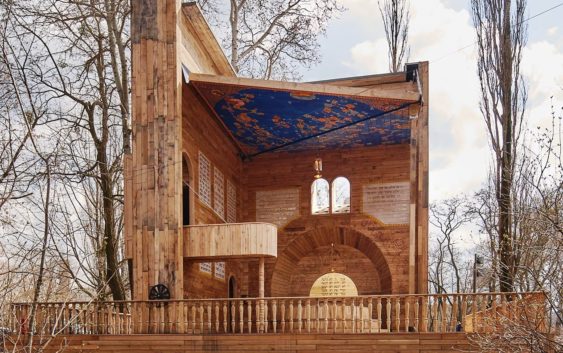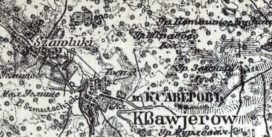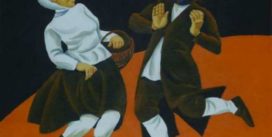The Babyn Yar Holocaust Memorial presented plans for 2022

The BYHMC presented work plans for 2022, as well as reported on the activities conducted in 2021. The presentation for the Supervisory Board of the Memorial Center took place on December 21, and on December 22 – it was presented to the Public Council.
In 2022, the Memorial Center will open the first museum space on the territory of Babyn Yar – Kurgan. The object was designed by the architectural studio SUB (Berlin). “This project will be our major focus in 2022. This event will mark the end of the presentation of the first stage of the museum complex, the first phase of the construction of the Memorial Center,” – said the artistic director of the Babyn Yar Holocaust Memorial Center Ilya Khrzhanovsky. “We are creating the first museum built on the site of mass shootings. Babyn Yar is one of the most important symbols of the Holocaust. Babyn Yar is a sacred place, a place where we can study various tragic aspects of human behavior. It is a place where we can imagine what once happened to understand what is happening now and discern what might happen tomorrow.”
Kurgan will show the history of the Babyn Yar tragedy using 3D modeling technology developed by the Center for Spatial Technologies. The display space of the museum will depict the tract during the first massacres on September 29–30, 1941: the landscape, crowds of people before the shooting began, and places of murders. On the outside, the museum space will resemble mounds – ancient burials in the form of a hill made of soil and stones, traditional for the Ukrainian steppes.
The goal of the Memorial Center is to create the largest memorial museum ensemble in Europe on the territory of Babyn Yar. It will include about ten museums, as well as a series of art installations. Following the Kurgan in 2023, the Museum of the History of Oblivion of the Babyn Yar Tragedy will be built.
Natan Sharansky, chairman of the Supervisory Board of the Babyn Yar Holocaust Memorial Center, expressed his opinion of future projects. “It is very significant that the first museum will be Kurgan. Since Babyn Yar is, first of all, the largest symbol of the Holocaust, the largest grave in the history of the Holocaust – it is important to show how this crime was committed. The fact that the second museum will be the Museum of the History of Oblivion of the Babyn Yar Tragedy is also very symbolic, considering that Babyn Yar is a symbol of attempts to destroy the memory of the Holocaust. A very important question is why the Soviet government, instead of making the Holocaust a big event to maintain its victory, suddenly decided to destroy the memory. If was able to tell how this Soviet policy of destroying the memory of the Holocaust began (literally 2 years after the Holocaust itself) – it would be very interesting.”
The formation of a holistic vision for the memorial complex and the creation of the master plan are among the key goals that BYHMC set for 2022.
“A masterlan is an incredibly significant step in the process of what we are doing. It determines the patterns of development for years, for decades to come,” said curator of the Architectural Advisory Board of the Holocaust Memorial Center Nick Axel. – We are going to be organizing an open ideas competition for this masterplan. The point of this is to generate and to develop as wide as possible range of approaches and ideas about how the territory of Babyn Yar can be conceptualized and structured. We are planning to show the competition directly with over 150 universities and hundreds and hundreds of practices. The jury will be comprised of members from the Architectual Advisory Board, the Babyn Yar Holocaust Memorial Center, and the group of high-profile external advisors. After the competition, we plan to work closely with the individual practices on developing their conceptual visions for the site. Working in this way with individual practices closely and in dialogue has been highly successful for us before. This is actually the way that we are now building for the Kurgan and the Museum of The History of Oblivion of the Babyn Yar tragedy.”
In 2022, Memorial also aims to strengthen the academic direction, collaborating with a range of Ukrainian historians of the young generation. The study of the gender aspects of the Holocaust will take a special place.
Next year, BYHMC will begin a strategic partnership with the French organization Yahad-In Unum, which – for 20 years – has been investigating previously unknown places of execution of Holocaust victims in Eastern Europe. Together with the international independent publisher De Gruyter (Berlin), BYHMC will publish the scientific journal “Eastern European Holocaust Studies.” It will publish theoretically sophisticated, and empirically grounded original research in the field of Holocaust and World War II.
In 2021, Babyn Yar Holocaust Memorial Center implemented 36 projects. “We had a key strategic goal – to turn the Memorial into a stable institution and to strengthen the perception of the Foundation in a status, without which it is impossible to discuss or implement any initiatives regarding the Holocaust. In the last two years, we managed to create the first phase of the Memorial (which consists of a spiritual space – the symbolic synagogue “Place for Reflection”, The Crystal Wall of Crying by Marina Abramovic, the monument to the Kurenivska tragedy, the installation “A Look Into the Past”). Of course, this is just the beginning of the work done on the territory with a radius of only 300 meters. In 2021 alone, almost 240 thousand people visited our facilities. Babyn Yar is no longer a place of oblivion,” – highlighted the CEO of the Babyn Yar Holocaust Memorial Center Max Yakover.
In 2021, the Memorial Center became an important space for events, debates and academic conferences dedicated to the subject of the Holocaust. On October 6, in partnership with the government, BYHMC organized an official ceremony dedicated to the 80th anniversary of the Babyn Yar tragedy. Many prominent leaders attended the event, including the president of Ukraine Volodymyr Zelenskyy, the presidents of Germany and Israel – Frank-Walter Steinmeier and Yitzhak Herzog. On the occasion of the 80th anniversary of the tragedy, with the help of the Ministry of Education and Science, the National Lesson of Memory was organized. Over a million students participated in the lesson from 7 thousand Ukrainian schools.
Science and education projects were among the focus areas in 2021. By the end of the year, the online archive of the Memorial Center already contains more than 1.7 million documents of the 20th century. The researchers at the center have restored the names of a third part of all the victims of Babyn Yar (28.5 thousand names). The names of more than 160 Nazi soldiers who massacred Jews in the tract were identified.
“Over the past 2 years, we have made significant progress; however, it only gives us a better understanding of the extremely long road ahead. It is important for us to forge partnerships with museums and key European organizations involved in Holocaust research and remembrance. We will look for partnerships with Jewish, Ukrainian organizations and Holocaust museums,” said Ruslan Kavatsiuk, board member of the Babyn Yar Holocaust Memorial Center.
“We have witnessed a paradigm shift in public opinion, in public relations and in the accomplishments that the Holocaust Memorial Center at Babyn Yar has made over the past year. This is a huge project that will change the way Ukraine definitely sees its history during World War II and what happened in Ukraine, because so many people do not even know about it, do not understand it; and this will give them the opportunity that – as we saw – many hundreds of thousands of people have already benefited from the successes of the center. This is a project for all people – not only for Ukraine, but for the whole world,” stressed a member of the Supervisory Board, Chief Rabbi of Kyiv and Ukraine Yakov Dov Bleich.
The presented projects also received positive feedback from the members of the Public Council. “I would also like to thank you for the work you have done to mark the 80th anniversary of perpetuating the tragedy of Babyn Yar. It is very pleasant that this work continues. It is not a fragmented vision that emerges, but a general conceptual picture of this sacred place. Any object that is created here, a memorial object is another step towards perpetuating the memory of the victims of Babyn Yar”, noted the member of the Public Council, First deputy of Director General of the National Historical and Memorial Reserve “Babyn Yar” Borys Glazunov.
Diana Popova, a member of the Public Council, an adviser to the Kyiv mayor on culture and project development, referred to the official ceremony dedicated to the 80th anniversary of the Babyn Yar tragedy as “a unique case”. “Several times during the autumn I had the opportunity to visit Babyn Yar, and I understand that the work done was not in vain. More and more people are coming there.”
“In front of my eyes, there were several attempts to create a memorial, a museum after this terrible tragedy,” said Borys Zabarko, a member of the Public Council of the Memorial Center, Chairman of the Association of Jews – former prisoners of ghetto and Nazi concentration camps. “But this work is multifaceted, systemic. Unfortunately, of all those people, people from Kyiv, who were in this place and survived, only Raisa Maistrenko is still alive. But all over Ukraine, in forty cities and villages, large and small, there are still those who survived the Holocaust. We are waiting to see the project come to life.”
Member of the Public Council, Minister of Foreign Affairs of Ukraine (2010–2012, 2013–2015)
Kostiantyn Hryshchenko highlighted that the Holocaust Memorial Center “Babyn Yar” should be different from all the world’s Holocaust museums. “We all have the opportunity to visit – at least virtually – other memorials. This memorial should be unique, anchored to the place, to the historical era. In this regard, I would like to draw your attention to historical research. It is important to show what the life of the Jewish community was like before this tragedy, how it was destroyed, how these events pushed the further development of Jewish life in Ukraine and beyond. It seems to me that this is a very important aspect that needs to be incorporated into other, including visual, projects.”






